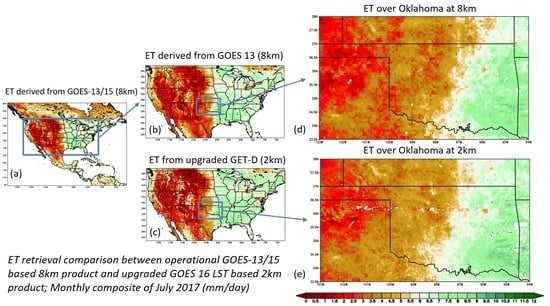Evapotranspiration Data Product from NESDIS GET-D System Upgraded for GOES-16 ABI Observations
Abstract
1. Introduction
2. GET-D and Its Theoretic Basis-ALEXI Model
3. Description of the Upgraded GET-D System
3.1. System Design
3.2. System Inputs
3.2.1. GOES Observations and Other Satellite Data
3.2.2. Meteorological Data
3.2.3. Static Ancillary Data
3.3. Key System Components
3.4. System Output
4. Results
4.1. Upgraded GET-D Products and Analysis of Product Consistency
4.2. Validation Results Comparing with In Situ ET Measurements
5. Discussion and Conclusions
Author Contributions
Funding
Acknowledgments
Conflicts of Interest
References
- Sato, N.; Sellers, P.J.; Randall, E.K.; Schneider, J.; Shukla, J.; Kinter III, J.L.; Hou, Y.T.; Albertazzi, E. Effects of implementing the simple biosphere model (Sib) in a general circulation model. J. Atmos. Sci. 1989, 46, 2757–2782. [Google Scholar] [CrossRef]
- Allen, R.G.; Pereira, L.S.; Raes, D.; Smith, M. Crop evapotranspiration: Guidelines for computing crop water requirements. In FAO Irrigation and Drainage Paper 56; FAO: Rome, Italy, 1998. [Google Scholar]
- Allen, R.G.; Tasumi, M.; Morse, A.; Trezza, R. A Landsat-based energy balance and evapotranspiration model in Western US water rights regulation and planning. Irrig. Drain. Syst. 2005, 19, 251–268. [Google Scholar] [CrossRef]
- Wetherald, R.T.; Manabe, S. Cloud Feedback Processes in a General Circulation Model. J. Atmos. Sci. 1988, 45, 1397–1416. [Google Scholar] [CrossRef]
- Rabin, R.M.; Stadler, S.; Wetzel, P.J.; Stensrud, D.J.; Gregory, M. Observed Effects of Landscape Variability on Convective Clouds. Bull. Am. Meteorol. Soc. 1990, 71, 272–280. [Google Scholar] [CrossRef]
- Bastiaanssen, W.G.M.; Menenti, M.; Feddes, R.A.; Holtslag, A.A.M. A remote sensing surface energy balance algorithm for land (SEBAL). 1. Formulation. J. Hydrol. 1998, 212, 198–212. [Google Scholar] [CrossRef]
- Bastiaanssen, W.G.M.; Pelgrum, H.; Wang, J.; Ma, Y.; Moreno, J.F.; Roerink, G.J.; van der Wal, T. A remote sensing surface energy balance algorithm for land (SEBAL).: Part 2: Validation. J. Hydrol. 1998, 212, 213–229. [Google Scholar] [CrossRef]
- Loague, K.M.; Freeze, R.A. A Comparison of Rainfall-Runoff Modeling Techniques on Small Upland Catchments. Water Resour. Res. 1985, 21, 229–248. [Google Scholar] [CrossRef]
- Norman, J.M.; Becker, F. Terminology in thermal infrared remote sensing of natural surfaces. Agric. For. Meteorol. 1995, 77, 153–166. [Google Scholar] [CrossRef]
- Kustas, W.P.; Norman, J.M. Use of remote sensing for evapotranspiration monitoring over land surfaces. Hydrol. Sci. J. 1996, 41, 495–516. [Google Scholar] [CrossRef]
- Courault, D.; Seguin, B.; Olioso, A. Review on estimation of evapotranspiration from remote sensing data: From empirical to numerical modeling approaches. Irrig. Drain. Syst. 2005, 19, 223–249. [Google Scholar] [CrossRef]
- Vinukollu, R.K.; Wood, E.F.; Ferguson, C.R.; Fisher, J.B. Global estimates of evapotranspiration for climate studies using multi-sensor remote sensing data: Evaluation of three process-based approaches. Remote Sens. Environ. 2011, 115, 801–823. [Google Scholar] [CrossRef]
- Anderson, M.C.; Norman, J.M.; Diak, G.R.; Kustas, W.P.; Mecikalski, J.R. A two-source time-integrated model for estimating surface fluxes using thermal infrared remote sensing. Remote Sens. Environ. 1997, 60, 195–216. [Google Scholar] [CrossRef]
- Kalma, J.D.; McVicar, T.R.; McCabe, M.F. Estimating Land Surface Evaporation: A Review of Methods Using Remotely Sensed Surface Temperature Data. Surv. Geophys. 2008, 29, 421–469. [Google Scholar] [CrossRef]
- Gillies, R.R.; Kustas, W.P.; Humes, K.S. A verification of the ‘triangle’ method for obtaining surface soil water content and energy fluxes from remote measurements of the Normalized Difference Vegetation Index (NDVI) and surface e. Int. J. Remote Sens. 1997, 18, 3145–3166. [Google Scholar] [CrossRef]
- Allen, R.; Irmak, A.; Trezza, R.; Hendrickx, J.M.H.; Bastiaanssen, W.; Kjaersgaard, J. Satellite-based ET estimation in agriculture using SEBAL and METRIC. Hydrol. Process. 2011, 25, 4011–4027. [Google Scholar] [CrossRef]
- Allen, R.G.; Tasumi, M.; Trezza, R. Satellite-Based Energy Balance for Mapping Evapotranspiration with Internalized Calibration (METRIC)—Model. J. Irrig. Drain. Eng. 2007, 133, 380–394. [Google Scholar] [CrossRef]
- Mu, Q.; Heinsch, F.A.; Zhao, M.; Running, S.W. Development of a global evapotranspiration algorithm based on MODIS and global meteorology data. Remote Sens. Environ. 2007, 111, 519–536. [Google Scholar] [CrossRef]
- Hain, C.R.; Crow, W.; Mecikalski, J.R.; Anderson, M.C.; Holmes, T.R.H. An intercomparison of available soil moisture estimates from thermal-infrared and passive microwave remote sensing and land-surface modeling. J. Geophys. Res. 2011, 116. [Google Scholar] [CrossRef]
- Anderson, M.C.; Hain, C.; Otkin, J.; Zhan, X.; Mo, K.; Svoboda, M.; Wardlow, B.; Pimstein, A. An Intercomparison of Drought Indicators Based on Thermal Remote Sensing and NLDAS-2 Simulations with U.S. Drought Monitor Classifications. J. Hydrometeorol. 2013, 14, 1035–1056. [Google Scholar] [CrossRef]
- Anderson, M.C.; Hain, C.R.; Wardlow, B.; Pimstein, A.; Mecikalski, J.R.; Kustas, W.P. Evaluation of drought indices based on thermal remote sensing of evapotranspiration over the continental U.S. J. Clim. 2011, 24, 2025–2044. [Google Scholar] [CrossRef]
- Anderson, M.C.; Norman, J.M.; Mecikalski, J.R.; Otkin, J.P.; Kustas, W.P. A climatological of surface fluxes and moisture stress across the continental United States based on Thermal Infrared Remote Sensing. Part I: Model formulation. J. Geophys. Res. 2007, 112, D11112. [Google Scholar] [CrossRef]
- Kustas, W.P.; Norman, J.M. A two-source approach for estimating turbulent fluxes using multiple angle thermal infrared observations. Water Resour. Res. 1997, 33, 1495–1508. [Google Scholar] [CrossRef]
- Fang, L.; Hain, C.R.; Zhan, X.; Anderson, M.C. An inter-comparison of soil moisture data products from satellite remote sensing and a land surface model. Int. J. Appl. Earth Obs. Geoinf. 2016, 48, 37–50. [Google Scholar] [CrossRef]
- Brown, J.F.; Wardlow, B.D.; Tadesse, T.; Hayes, M.J.; Reed, B.C. The Vegetation Drought Response Index (VegDRI): A New Integrated Approach for Monitoring Drought Stress in Vegetation. GIScience Remote Sens. 2008, 45, 16–46. [Google Scholar] [CrossRef]
- Moran, M.S. Thermal Infrared Measurement as an Indicator of Plant Ecosystem Health; Taylor and Francis: Abingdon, UK, 2003. [Google Scholar]
- Otkin, J.A.; Anderson, M.C.; Hain, C.; Mladenova, I.E.; Basara, J.B.; Svoboda, M. Examining Rapid Onset Drought Development Using the Thermal Infrared–Based Evaporative Stress Index. J. Hydrometeorol. 2013, 14, 1057–1074. [Google Scholar] [CrossRef]
- Otkin, J.A.; Anderson, M.C.; Hain, C.; Svoboda, M. Examining the Relationship between Drought Development and Rapid Changes in the Evaporative Stress Index. J. Hydrometeorol. 2014, 15, 938–956. [Google Scholar] [CrossRef]
- Li, Z.; Hain, C.; Fang, L.; Zhan, X.; Anderson, M.C. GOES Evapotranspiration and Drought Product System (GET-D). In Proceedings of the 30th Conference on Hydrology of American Meteorological Society Annual Meeting, New Orlean, LA, USA, 10–15 January 2016. [Google Scholar]
- Zhan, X.; Fang, L.; Yin, J.; Schull, M.; Liu, J.; Hain, C.; Anderson, M.; Kustas, W.; Kalluri, S. Remote Sensing of Evapotranspiration for Global Drought Monitoring. In Global Drought and Flood Prediction; Wu, H., Lettermaier, D., Ward, P., Tang, Q., Eds.; AGU Book: Hoboken, New Jersey, 2019. [Google Scholar]
- Zhan, X.; Hain, C.; Fang, L.; Li, Z. GOES Evapotranspiration (ET) and Drought Product System Algorithm Theoretical Basis Document; NOAA NESDIS STAR; NOAA: Silver Spring, MD, USA, 2016. [Google Scholar]
- Anderson, M.C.; Norman, J.M.; Kustas, W.P.; Li, F.; Prueger, J.H.; Mecikalski, J.R. Effects of vegetation clumping on two-source model estimates of surface energy fluxes from an agricultural landscape during SMACEX. J. Hydrometeorol. 2005, 6, 892–909. [Google Scholar] [CrossRef]
- Mecikalski, J.M.; Diak, G.R.; Anderson, M.C.; Norman, J.M. Estimating fluxes on continental scales using remotely sensed data in an atmosphere-land exchange model. J. Appl. Meteorol. 1999, 38, 1352–1369. [Google Scholar] [CrossRef]
- McNaughton, K.J.; Spriggs, T.W. A mixed-layer model for regional evaporation. Bound. Layer Meteorol. 1986, 74, 243–262. [Google Scholar] [CrossRef]
- Hain, C.R.; Mecikalski, J.R.; Anderson, M.C. Retrieval of an available water-based soil moisture proxy from thermal infrared remote sensing. Part I: Methodology and validation. J. Hydrometeorol. 2009, 10, 665–683. [Google Scholar] [CrossRef]
- Hansen, M.C.; Defries, R.S.; Townshend, J.R.G.; Sohlberg, R. Global land cover classification at 1 km spatial resolution using a classification tree approach. Int. J. Remote Sens. 2000, 21, 1331–1364. [Google Scholar] [CrossRef]
- Suyker, A.E.; Verma, S.B. Coupling of carbon dioxide and water vapor exchanges of irrigated and rainfed maize–soybean cropping systems and water productivity. Agric. For. Meteorol. 2010, 150, 553–563. [Google Scholar] [CrossRef]
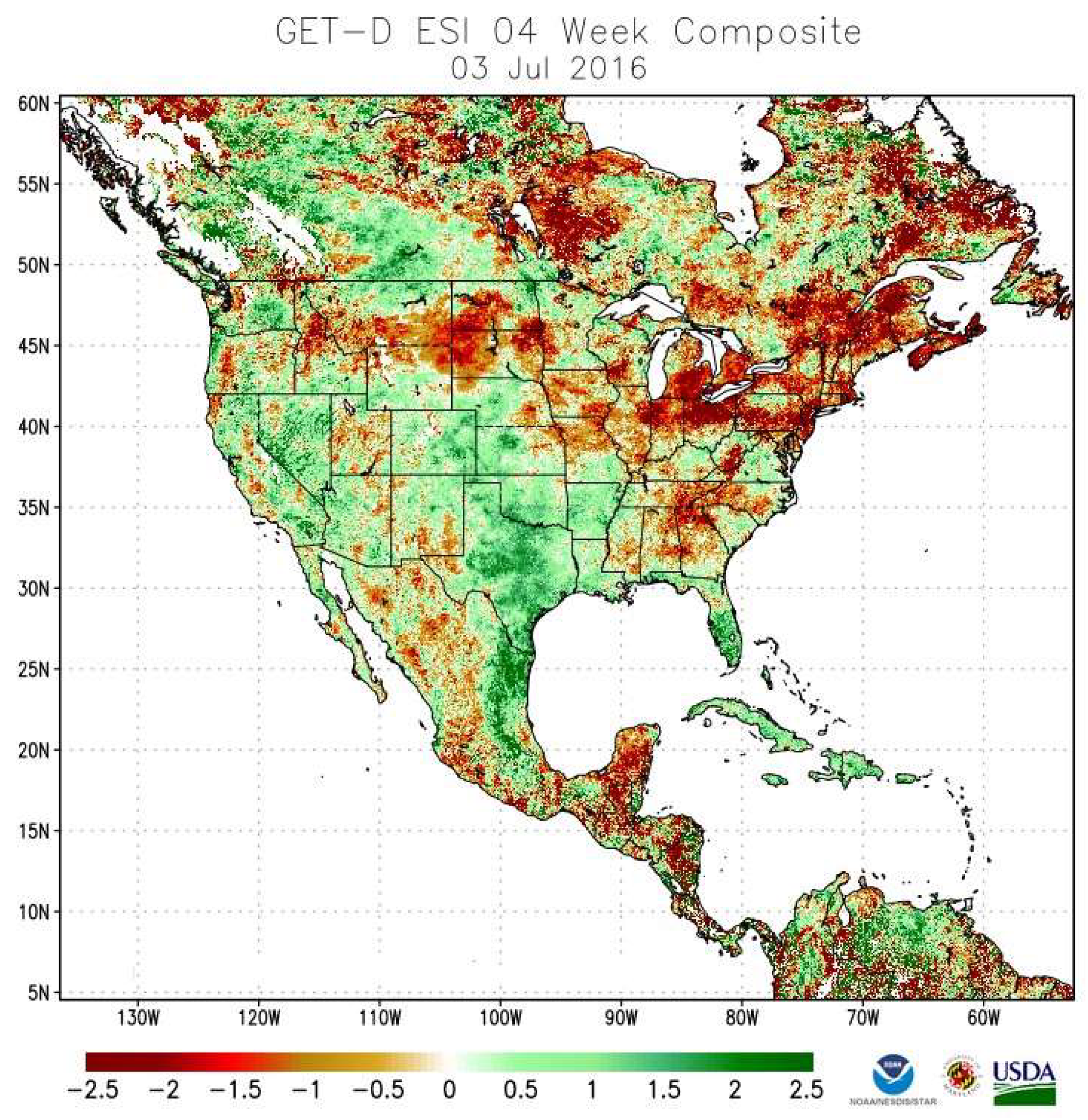

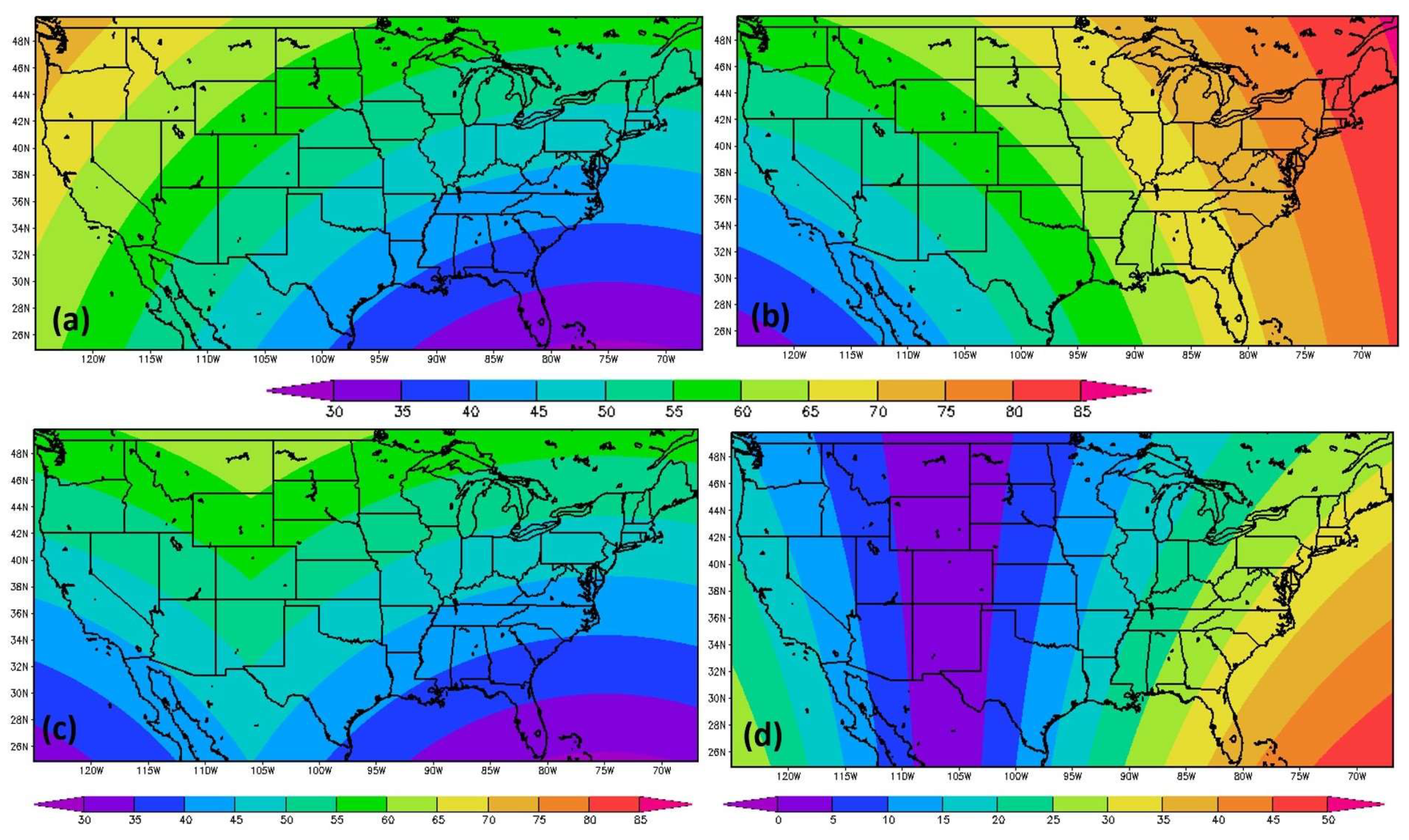
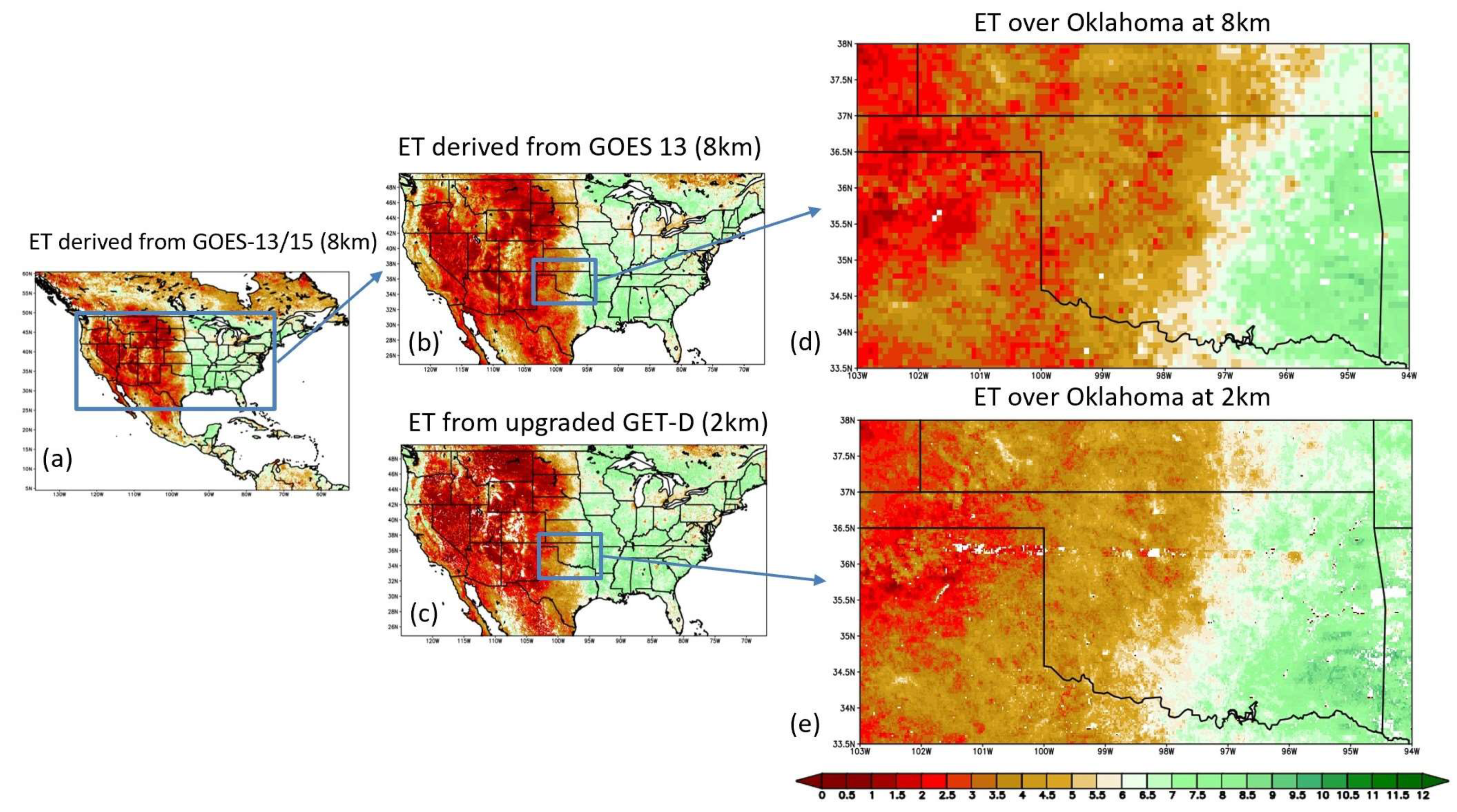
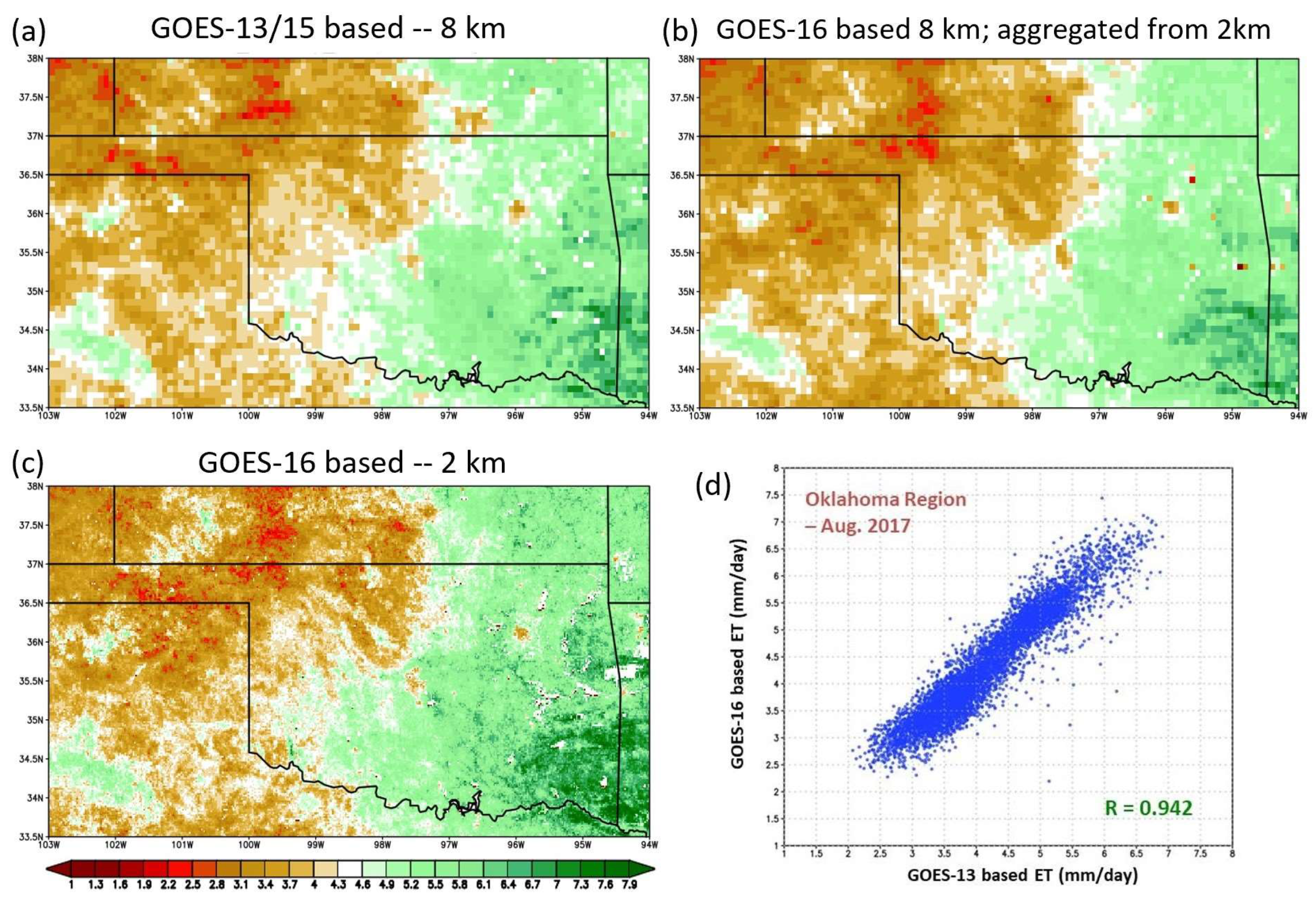

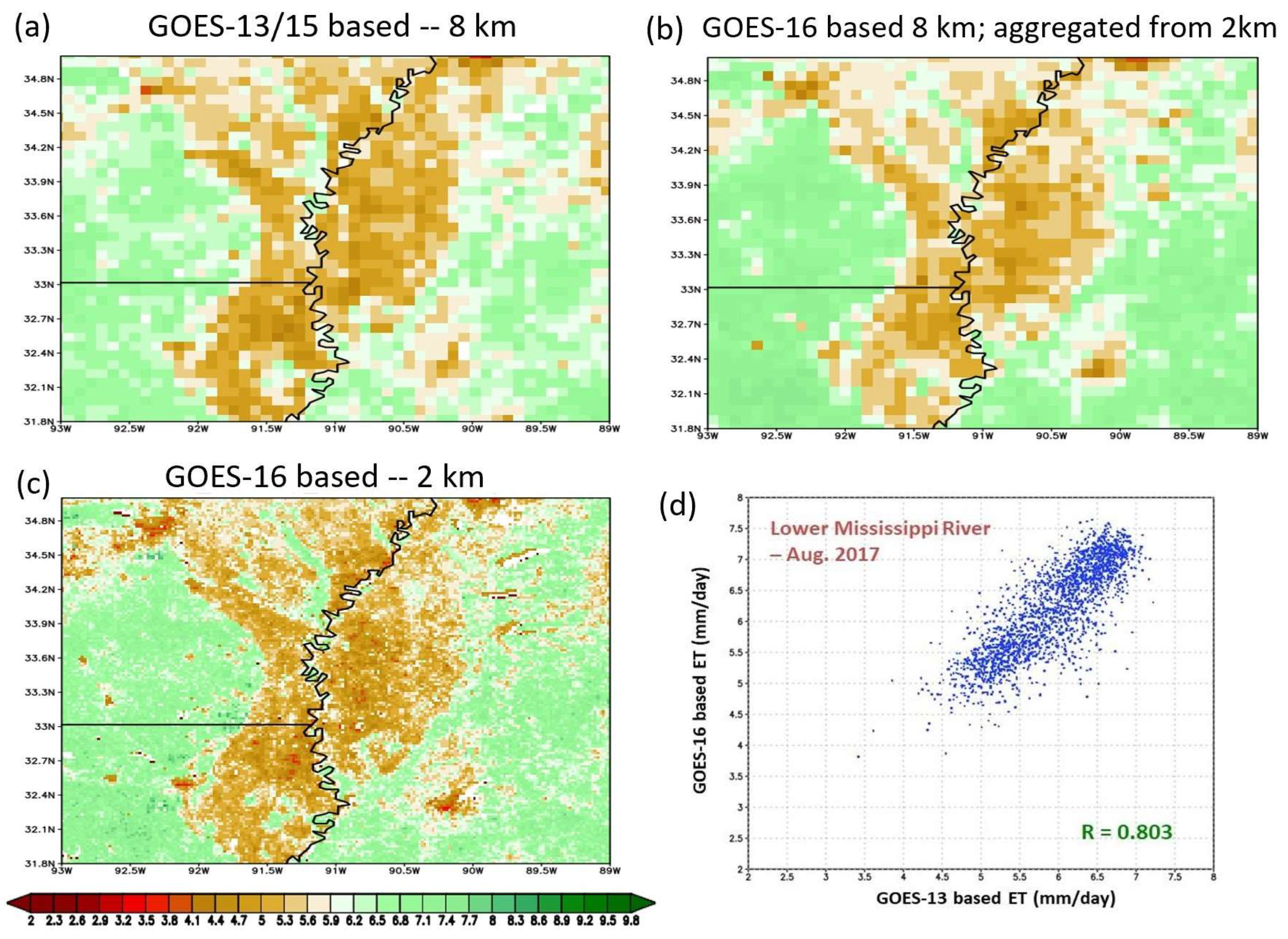
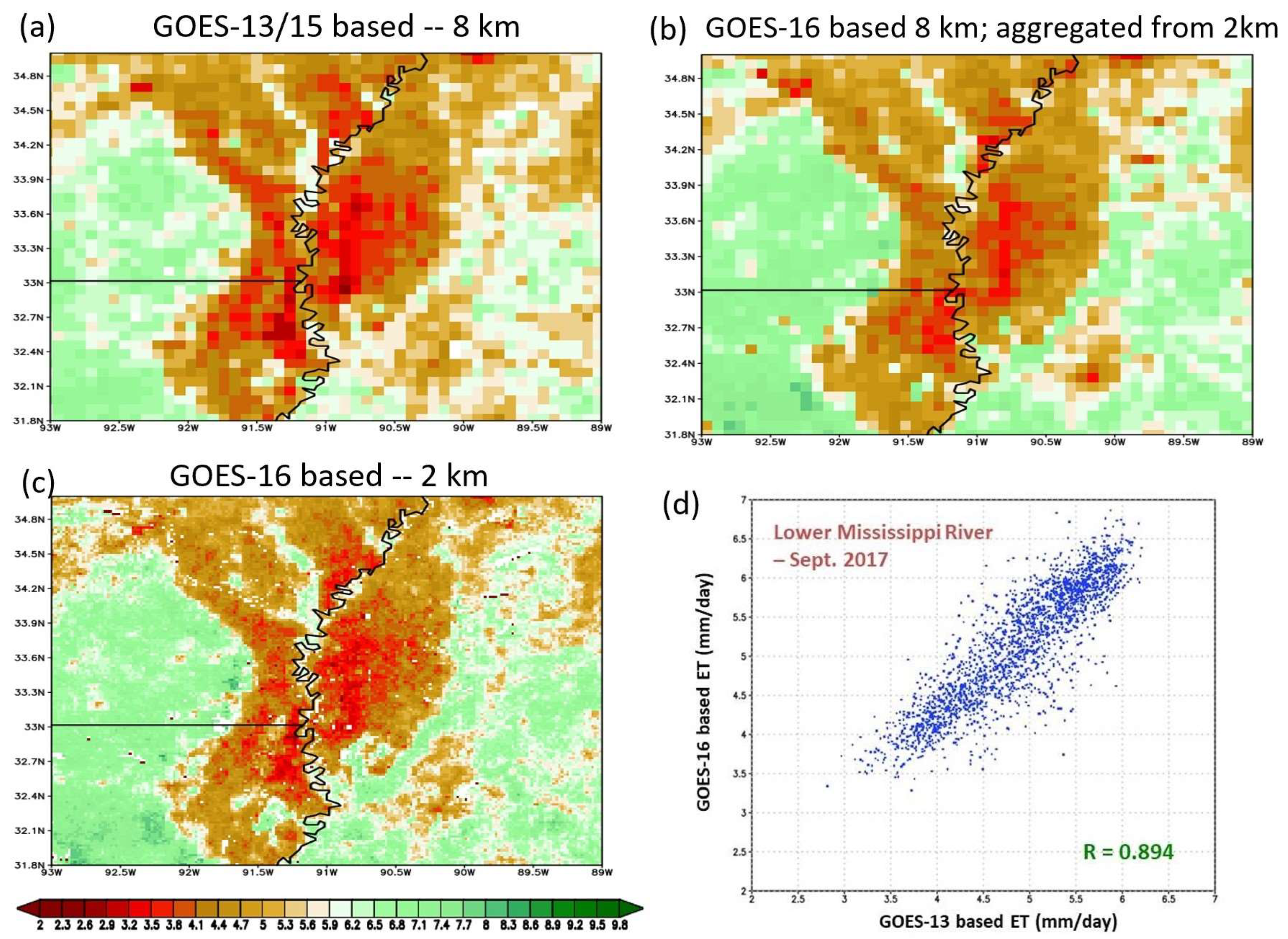
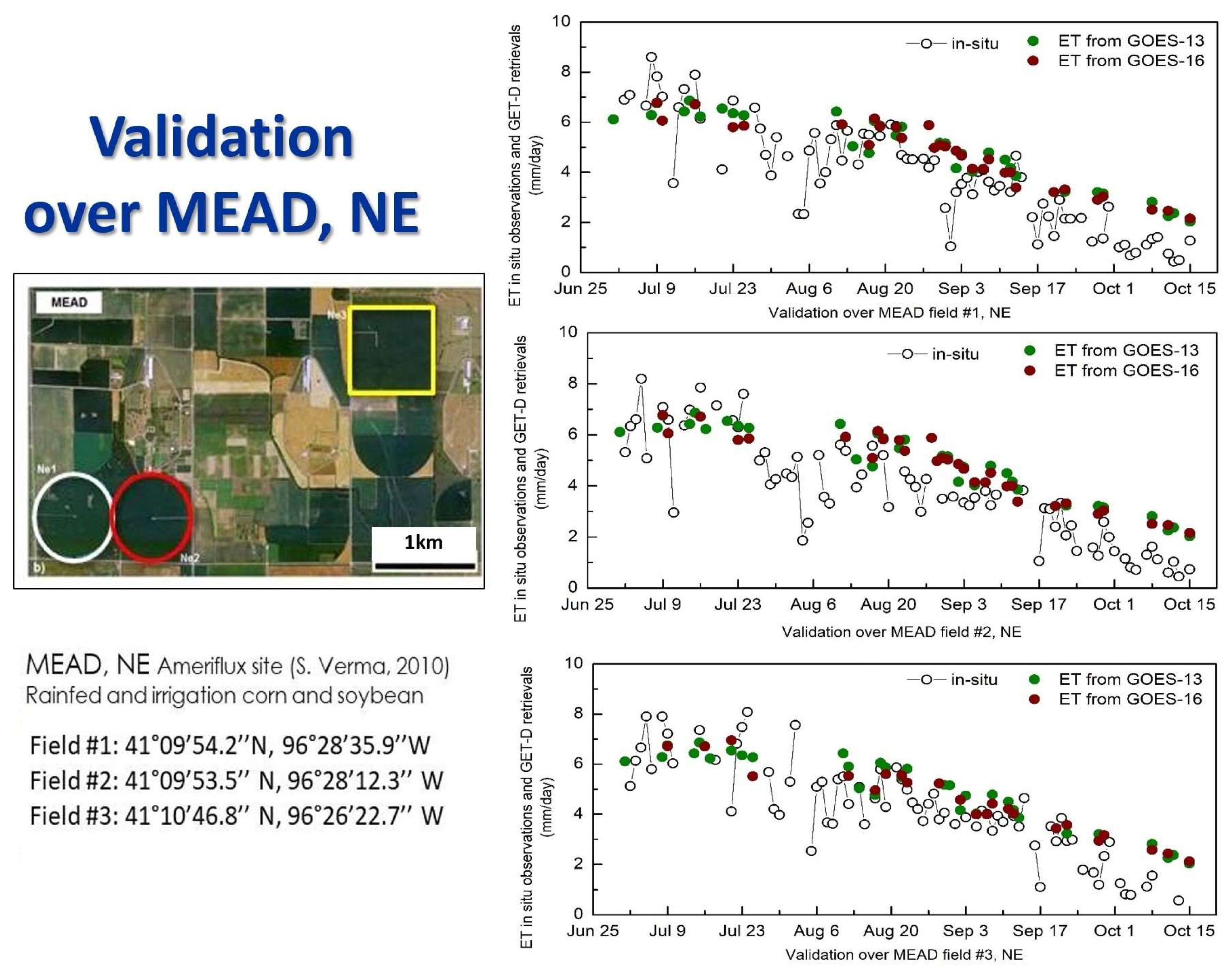
| Name | Data Source | Resolution | Spatial Coverage | Description |
|---|---|---|---|---|
| GOES thermal observations | GOES-R | 2 km | Full Disk/CONS | Primary option: Channel 13 of GOES-16 and GOES-17 ABI L1b Radiance product (ABI-L1b-RadF) Second option: GOES LST product (OR_ABI-L2-LSTC) |
| Clear Sky Mask | GOES-R | 2 km | Full Disk | GOES-R Clear Sky Mask product (OR_ABI-L2-ACMF) |
| Insolation | GSIP | 12.5 km | North America | GSIP L2 real-time insolation; |
| Vegetation Index | VIIRS | 4 km | Global | NESDIS GVF (inverted to LAI) |
| Solar zenith | GOES-R | 2 km | Full Disk | GOES-R solar zenith angles |
| View zenith | GOES-R | 2 km | Full Disk | GOES-R view zenith angle |
| Snow Mask | IMS | 24 km | Northern Hemisphere | NOAA IMS Daily Northern Hemisphere Snow and Ice Analysis |
| NARR | CFS | |
|---|---|---|
| Spatial Coverage | Corners of grids (1.000001N, 145.5W; 0.897945N, 68.32005W; 46.3544N, 2.569891W; 46.63433N, 148.6418E) | Global (180 ~ −180; 90 ~ −90) |
| Spatial Resolution | 0.3 degree | 0.5 degree |
| Temporal resolution | 3 hour | 6 hour |
| Projection | LambertConformal | Gaussian Cylindrical |
| Variables | NARR | CFS - ID | Type |
|---|---|---|---|
| Temperature (1000 mb to 100 mb) | TMP:100 mb–1000 mb | TMP:100 mb–1000 mb | 3-D |
| Geopotential Height (1000 mb to 100 mb) | HGT:100 mb–1000 mb | HGT:100 mb–1000 mb | 3-D |
| RH/SPFH at Pressure (1000 mb to 100 mb) | SPFH: 100 mb–1000 mb | RH:100 mb–1000 mb | 3-D |
| Surface temperature | TMP:30 m above ground | TMP:80 m above ground | 2-D |
| Surface pressure | PRESSURE: 30 m above surface | PRES: 80 m above ground | 2-D |
| Surface specific humidity/relative humidity/mixing ratio | SPFH:30 m above ground | SPFH: 80 m above ground | 2-D |
| Surface geopotential height | narr_sfc_height.dat | 80 m constant | 2-D |
| Surface wind speed | UGRD:30 m above ground VGRD:30 m above ground | UGRD:80 m VGRD: 80 m | 2-D |
| Down-welling longwave radiation | DLWRF:sfc | Downward Long-Wave Rad. Flux | 2-D |
| Variables | Spatial Resolution | Unit | Format | Description |
|---|---|---|---|---|
| ET | 2 km | mm day−1 | NetCDF, GRIB2, PNG | Daily ET |
| QC for ET | 2 km | -- | NetCDF, GRIB2 | Quality control flag for retrieved ET |
| Fluxes | 2 km | Wm−2 day−1 | NetCDF, GRIB2, PNG | Daily short wave down, long wave down, long wave up and net radiation |
| QC for flux | 2 km | -- | NetCDF, GRIB2 | Quality control flag for retrieved fluxes |
| Bias | RMSE | Correlation * | N | ||||
|---|---|---|---|---|---|---|---|
| GOES-13 Based | GOES-16 Based | GOES-13 Based | GOES-16 Based | GOES-13 Based | GOES-16 Based | ||
| MEADsite1 | 0.555 | 0.601 | 1.318 | 1.215 | 0.887 | 0.885 | 26 |
| MEADsite2 | 0.561 | 0.546 | 1.094 | 0.906 | 0.860 | 0.885 | 23 |
| MEADsite3 | 0.754 | 0.617 | 1.132 | 1.023 | 0.949 | 0.974 | 21 |
| Average | 0.623 | 0.588 | 1.181 | 1.048 | 0.899 | 0.914 | |
© 2019 by the authors. Licensee MDPI, Basel, Switzerland. This article is an open access article distributed under the terms and conditions of the Creative Commons Attribution (CC BY) license (http://creativecommons.org/licenses/by/4.0/).
Share and Cite
Fang, L.; Zhan, X.; Schull, M.; Kalluri, S.; Laszlo, I.; Yu, P.; Carter, C.; Hain, C.; Anderson, M. Evapotranspiration Data Product from NESDIS GET-D System Upgraded for GOES-16 ABI Observations. Remote Sens. 2019, 11, 2639. https://doi.org/10.3390/rs11222639
Fang L, Zhan X, Schull M, Kalluri S, Laszlo I, Yu P, Carter C, Hain C, Anderson M. Evapotranspiration Data Product from NESDIS GET-D System Upgraded for GOES-16 ABI Observations. Remote Sensing. 2019; 11(22):2639. https://doi.org/10.3390/rs11222639
Chicago/Turabian StyleFang, Li, Xiwu Zhan, Mitchell Schull, Satya Kalluri, Istvan Laszlo, Peng Yu, Corinne Carter, Christopher Hain, and Martha Anderson. 2019. "Evapotranspiration Data Product from NESDIS GET-D System Upgraded for GOES-16 ABI Observations" Remote Sensing 11, no. 22: 2639. https://doi.org/10.3390/rs11222639
APA StyleFang, L., Zhan, X., Schull, M., Kalluri, S., Laszlo, I., Yu, P., Carter, C., Hain, C., & Anderson, M. (2019). Evapotranspiration Data Product from NESDIS GET-D System Upgraded for GOES-16 ABI Observations. Remote Sensing, 11(22), 2639. https://doi.org/10.3390/rs11222639




